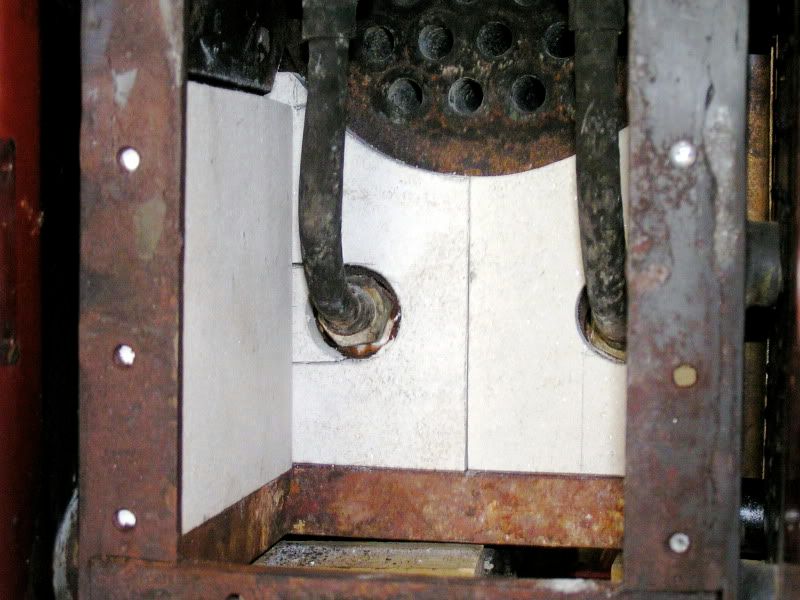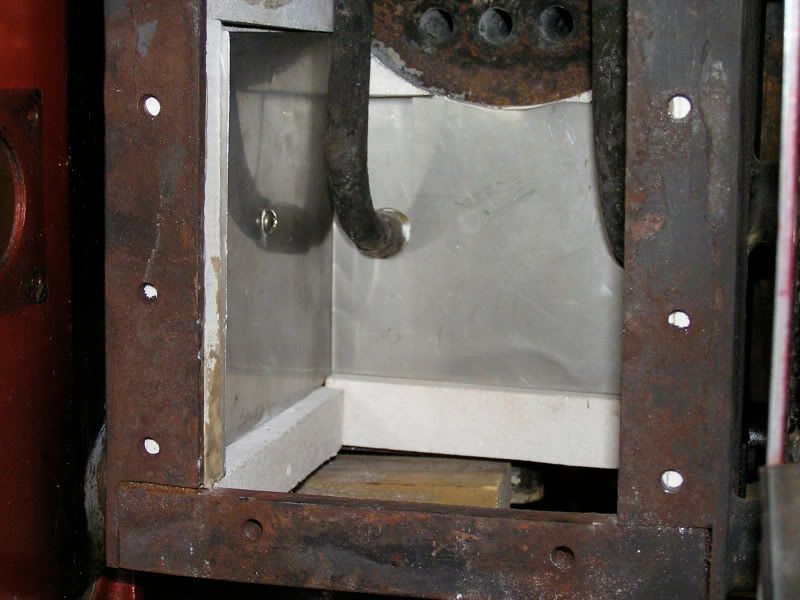fred55
Involved Member
  
Posts: 91
|
Post by fred55 on Dec 15, 2011 10:49:09 GMT
A leak in the briggs boiler turned out to be a cracked union in the syphon tube near the blowdown tee. Obviously the boiler has to come out , but I'm interested in opinions as designs have changed since 1987 when this one first hit the rails. The firebox is deep and narrow and has copper coil in a double circuit, then up the side to the crown sheet. There was little insulation of the pipes and they always seemed to unneccessarily reduce the firebox volume, and get in the way when stoking, however the boiler was otherwise in good condition. I'd love to get rid of the sypon, but how important is it? Is it an option to route the pipe directly without coils How reliable are water walls, they seem to be even more problematical. Having now experienced firebox steamout and water into hot fire, I wonder if I still believe in fusible plugs  Pete Attachments:
|
|
|
|
Post by Jim on Dec 15, 2011 19:31:37 GMT
Hi Fred, I don't know what the current AMBSC Steel Boiler code says re siphons. But when I designed mine the option to have just two direct water circulating legs was available. I went along that path as it was so much simpler and the legs were much 'easier' to replace if one should fail. The other advantage is that the legs are not buried in coals as with the coil style siphon The picture shows the setup in my 3" Burrell and taken at a time when I was replacing the refractory board lining. Hope this is of some help. Jim  |
|
fred55
Involved Member
  
Posts: 91
|
Post by fred55 on Dec 17, 2011 11:45:17 GMT
Thanks Jim that looks like a more sensible solution. The lining is new to me, is there more info on it somewhere?
Pete
|
|
|
|
Post by Jim on Dec 17, 2011 18:52:01 GMT
G'day Pete, The stuff I used was Pizza Oven tiles that I got from a BBQ shop and so far the have worked well. The problem I've found is that clinker forming on the refractory material can cause it to break up so this time I have added a covering of thin stainless steel sheet to keep the clinker off the tiles. So far it seems to be doing the job quite well.  |
|
fred55
Involved Member
  
Posts: 91
|
Post by fred55 on Dec 24, 2011 8:05:10 GMT
There's a new version of the boiler code due for release soon and I understand the syphons may be deleted altogether.
By the time I get the boiler out we may know the outcome.
Pete
|
|
|
|
Post by Jim on Dec 24, 2011 10:48:05 GMT
By the time I get the boiler out we may know the outcome. Pete I take it Pete that the front of the fire box isn't removable in the same way that mine is on the Burrell? It cetainly is a handy feature giving me full access to the siphon and tubes if they are ever in need of repair. Removing the requirement for siphons from the code would be a blessing. Jim |
|
|
|
Post by ianholder on Dec 27, 2011 20:41:03 GMT
When I was building my 7 1/4 Hunslet tank we had a talk by Keith Watson at our club while he was in England. He advocated the Briggs boiler and recomended leaving out any tubes in the firebox. I built mine without them and it steamed very well for many years. I dont have my copy of the Australian Boiler Code any more but I dont remember there being a requirement for syphons or coils, and Keith was not using them then as far as I know. The only difference with my boiler was that the barrel extended about a quarter of the way into the firebox. Hope you don't mind a Pom joining in! regards Ian
|
|
|
|
Post by Jim on Dec 28, 2011 20:11:56 GMT
G'day Ian,
I just checked my copy of the AMBSC Boiler Steel Boiler Code (1995 and still current) and the requirement for some form of water circulation device in the fire box is a mandatory requirement (3.16.4) The coil system that Fred has was from memory, a feature of the pre 1995 code. At the time I drew up the plans for my boiler I was told by the club inspector that the coil was no longer a requirement. Maybe that was what Keith was refering to in his talk.
I believe there is/was discussion about the usefulness of the siphons/circulation devices and talk of dropping the requirement for them in any revision of the code, it's all way over my head though.
Jim
|
|
|
|
Post by ianholder on Dec 28, 2011 20:32:53 GMT
It was 1980 that I was building the Hunslet, I don't know how often the code has been updated, but I don't understand why the coils or syphons should be a requirement. It does'nt add any thing to the safety of the boiler, if anything the opposite.
When I built the boiler I had a lot of adverse comments from people and I only found one other in England, but it worked and surprised some. You will like this, some one told me that it probably was successfull in Australia because the ambient temperature was higher! regards Ian
|
|
steam4ian
Elder Statesman
   One good turn deserves another
One good turn deserves another
Posts: 2,069
|
Post by steam4ian on Dec 29, 2011 11:12:27 GMT
G'day Ian
Without a syphon of some kind how does water circulate over the firebox crown sheet?
The water covering the crown sheet could be just over 10% of the crown sheet to wrapper distance according to code. That could be 5mm.
On a copper boiler about 70% of heat transfer is in the firebox.
Regards
Ian
|
|
|
|
Post by ianholder on Dec 30, 2011 20:33:50 GMT
The boiler was steel on my Hunslet, with a briggs boiler the backhead is semi-circular and the bottom gauge glass fitting was screwed in as low as possible. It is thus above the crown sheet and allowing for the size of the fitting with half a glass of water showing the water level was about 1 1/2" above the crown.
Syphons can also cause excess turbulence above the crown of the firebox, regards Ian
|
|
fred55
Involved Member
  
Posts: 91
|
Post by fred55 on Jan 2, 2012 1:59:42 GMT
Thanks for all the comments (from any continent ;D) This is the offending union. seems to have been sweated in situ when the firebox was attached. more... Attachments:
|
|
fred55
Involved Member
  
Posts: 91
|
Post by fred55 on Jan 2, 2012 2:04:14 GMT
Looks to my untrained eyes like it has overheated or become porous. Either way it is terminal. Attachments:
|
|
fred55
Involved Member
  
Posts: 91
|
Post by fred55 on Jan 2, 2012 2:08:41 GMT
Chopped some refactory out to see if I could get a socket on the fitting, but to no avail. Man, that stuff is hard and holds on like a Scotsman's grip on a five pound note! Back to undoing stuff to remove the boiler, this could take a while, even if I knew what I was doing  Jim, the firebox does appear to be seperate, but not detachable while the boiler is in the frames. BTW, half a glass gives about 35mm of water on the crown sheet. Pete. Attachments:
|
|
fred55
Involved Member
  
Posts: 91
|
Post by fred55 on Jan 3, 2012 11:28:50 GMT
Got a bit of help so took out the boiler. What a shocker of a job!. This is what I found when removing the blowdown fitting. No wonder it looked like it had overheated. Talked to expert (ex inspector who has built numerous boilers), and he is helping to prepare some coded steel pipe. Not looped, but direct like Jims Burrell, (syphons haven't yet been deleted from code) and larger unions. He will also do an ulrasonic test of boiler prior to repair. I will arrange the new unions with rodding access plugs for the blowdown and syphon. Attachments:
|
|
kwil
Part of the e-furniture

Posts: 383
|
Post by kwil on Jan 3, 2012 12:01:06 GMT
What have you been doing to avoid rust? It looks pretty flakey.
|
|
|
|
Post by Jim on Jan 3, 2012 21:18:30 GMT
What have you been doing to avoid rust? It looks pretty flakey. I don't know about others but I add a tannin water treatment to the boiler when filling it. At the end of the day's run and after blowing down I remove the front tube plate inspection plugs and leave the blow down valve open so air can circulate through the boiler keeping it dry and to prevent condensation forming. I've had no rust problems with my Briggs Boiler. Jim. |
|
fred55
Involved Member
  
Posts: 91
|
Post by fred55 on Jan 4, 2012 7:47:24 GMT
Pretty much as Jim, plus I leave a 40w light bulb burning in the firebox.
Have been using "Core" treatment with no probs, but supply dried up and had to use tannin/neutaliser. Might review that as surface rust noted on crown sheet.
Also the loco was moved with steam up, which involved a ramp, could be that shifted some sediment. Only found 2 flakey bits plus a fair bit of crud. Must blowdown more often
|
|
fred55
Involved Member
  
Posts: 91
|
Post by fred55 on Mar 19, 2012 12:58:52 GMT
Quick update. New tube (coded steel pipe) in place and no unions showing (covered with pyrocrete). Mini camera showed blowdown boss protruded into boiler, effectively preventing complete removal of crud. I will now blowdown more regularly, but also remove front tubeplate drain plug, (which is level with bottom of boiler) after each steaming, for a more complete clean. Also I will not use ramps with steam up.  Boiler code shows blowdown boss flush with inside of boiler (cant change mine now) and also Les Irwin advised that new Oz code, due out any day, has syphons as optional in new builds. Pete Attachments:
|
|
|
|
Post by Jim on Mar 19, 2012 21:35:57 GMT
The repair looks good Pete, well done.
Where did you get the pyrocrete from? I'm about due to do an overhaul of the Burrell, repaint etc which would give me a chance to do some repairs to the firebox.
Jim
|
|